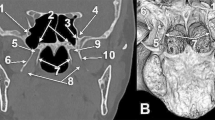Summary
The structure of the greater wing of the sphenoid in the region of the foramen ovale and sphenoidal angle is described in both the adult human and in two partly ossified human embryos. It is shown that the foramen ovale of man is enclosed by membrane bone, derived from a medial process associated with the scaphoid fossa, and a lateral tongue, the most dorsal part of which is present in many adults as a process on the lateral margin of the foramen. These structures are parts of an extensive membrane bone which forms the larger part of the greater wing of the sphenoid. It is shown that the foramen of Vesalius represents the site of fusion between this membrane bone and the more medial, cartilaginous, ala temporalis. Various inconstant patterns of grooves and foramina in the vicinity of the foramen ovale can be interpreted as arising from the interplay of the various parts of the membrane bone and the emissary venous plexus from the middle meningeal veins to the pterygoid plexus. The embryonic anlagen of the pterygo-sphenoidal and pterygo-spinous ligaments are described, and the association of these structures with the parts of the membrane bone are discussed.
Similar content being viewed by others
References
Beer GR de (1937) The development of the vertebrate skull. Oxford University Press, Oxford
Brunn A von (1891) Das Foramen pterygo-spinosum (Civinini) und der Porus crotaphiticobuccinatorius (Hyrtl). Anat Anz 7:96–104
Edinger T, Kitts DB (1954) The foramen ovale. Evolution, Lancaster, Pa. 8:389–404
Eisler P (1912) Die Muskeln des Stammes, in Bardeleben: Handbuch der Anatomie des Menschen Bd 2 Abt 2 Teil 1. Gustav Fischer, Jena
Fawcett E (1910) Notes on the development of the sphenoid. J Anat 44:207–222
Goodrich ES (1930) Studies on the structure and development of vertebrates. Macmillan, London
Grosse U (1893) Über das Foramen pterygo-spinosum (Civinini) und das Foramen crotaphiticobuccinatorium (Hyrtl). Anat Anz 8:321–348
Hershkowitz P (1977) Living new world monkeys, Vol 1. University of Chicago Press Chicago
Kuhn HJ (1971) Die Entwicklung und Morphologie des Schädels von Tachyglossus aculeatus. Abh Senckenb Naturforsch Ges 528:1–224
Padgett DH (1957) The development of the cranial venous system in man from the viewpoint of comparative anatomy. Contr Embryol 36:81–140
Patterson C (1977) Cartilage bones, dermal bones and membrane bones, or the exoskeleton versus the endoskeleton, In: Andrews, Miles and Walker: Problems in Vertebrate Evolution, 77–121. Academic Press, London
Presley R, Steel FLD (1976) On the homology of the alisphenoid. J Anat 121:441–459
Spee F Graf von (1896) Skeletlehre: Kopf, In: Bardeleben: Handbuch der Anatomie des Menschen Bd 1 Abt 2. Gustav Fischer, Jena
Starck D (1975) Embryologie. 3rd edn. Georg Thieme, Stuttgart
Starck D (1978) Das evolutive Plateau Säugetier. Sonderbd Naturwiss Hamburg 3:7–33
Steel FLD (1962) The sexing of long bones, with reference to the St. Bride's series of identified skeletons. J1 R Anthrop Inst. 92:212–222
Author information
Authors and Affiliations
Rights and permissions
About this article
Cite this article
James, T.M., Presley, R. & Steel, F.L.D. The foramen ovale and sphenoidal angle in man. Anat. Embryol. 160, 93–104 (1980). https://doi.org/10.1007/BF00315652
Accepted:
Issue Date:
DOI: https://doi.org/10.1007/BF00315652




